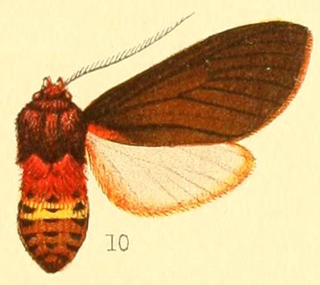
Ecuador, officially the Republic of Ecuador, is a country in northwestern South America, bordered by Colombia on the north, Peru on the east and south, and the Pacific Ocean on the west. Ecuador also includes the Galápagos Islands in the Pacific, about 1,000 kilometres (620 mi) west of the mainland. The capital city is Quito, which is also the largest city.

Anyphaenidae is a family of araneomorph spiders, sometimes called anyphaenid sac spiders. They are distinguished from the sac spiders of the family Clubionidae and other spiders by having the abdominal spiracle placed one third to one half of the way anterior to the spinnerets toward the epigastric furrow on the underside of the abdomen. In most spiders the spiracle is just anterior to the spinnerets. Like clubionids, anyphaenids have eight eyes arranged in two rows, conical anterior spinnerets and are wandering predators that build silken retreats, or sacs, usually on plant terminals, between leaves, under bark or under rocks. There are more than 500 species in over 50 genera worldwide.

UTC−05:00 is a time offset that subtracts five hours from Coordinated Universal Time (UTC). In North America, it is observed in the Eastern Time Zone during standard time, and in the Central Time Zone during the other eight months. The western Caribbean uses it year round.

Oncidium, abbreviated as Onc. in the horticultural trade, is a genus that contains about 330 species of orchids from the subtribe Oncidiinae of the orchid family (Orchidaceae). As presently conceived, it is distributed across much of South America, Central America, Mexico and the West Indies, with one species (O. ensatum) extending into Florida. Common names for plants in this genus include dancing-lady orchid and golden shower orchid.

The Ecuador national football team represents Ecuador in international football competitions and is controlled by the Ecuadorian Football Federation. They play official home matches at Estadio Olímpico Atahualpa in Quito.
Estadio Olímpico Atahualpa is a multi-purpose stadium in Quito, Ecuador. It is currently used mostly for football matches and has a capacity of 35,724.
The 1972 Federation Cup was the tenth edition of the most important competition between national teams in women's tennis. 31 nations participated in the tournament, which was held at Ellis Park in Johannesburg, South Africa from 20–25 March. South Africa defeated Great Britain in the final, in what was the first final not featuring United States or Australia, giving South Africa their first title. South Africa became the first team other than United States or Australia to win the Fed Cup.

The following outline is provided as an overview of and topical guide to South America.
Mazaeras is a genus of arctiine tussock moths in the family Erebidae.
Agyrta macasia is a moth of the subfamily Arctiinae. It was described by Schaus in 1924. It is found in Ecuador.

Mazaeras mediofasciata is a moth of the family Erebidae. It is found in Peru.
Mazaeras francki is a moth of the family Erebidae. It was described by Schaus in 1896. It is found in Brazil.
Mazaeras janeira is a moth of the family Erebidae. It was described by William Schaus in 1892. It is found in Brazilian states of Rio de Janeiro and Rio Grande do Sul.

Mazaeras soteria is a moth of the family Erebidae. It was described by Herbert Druce in 1900. It is found in Argentina.

Cheese buns or cheese breads may refer to a variety of small, baked, cheese-flavored rolls, a popular snack and breakfast food in Brazil, Colombia, Ecuador, Argentina and Paraguay. Cheese buns may be made with cassava or corn flour, or both, and cheese. In countries where the snack is popular, it is inexpensive and often sold from street vendors, in snack shops, and in grocery stores.
The IPSC Pan-American Handgun Championship is an IPSC level 4 championship hosted every third year in North- or South-America.
Xenoctenidae is a family of araneomorph spiders, created in 2017. The genera placed in the family have mainly come from the family Miturgidae, with one from the Ctenidae.










